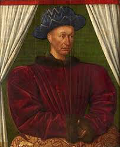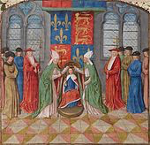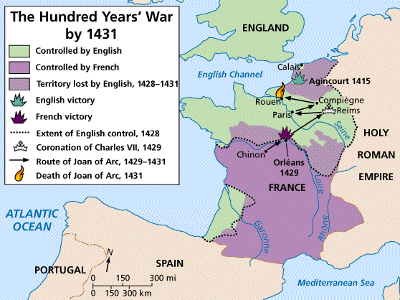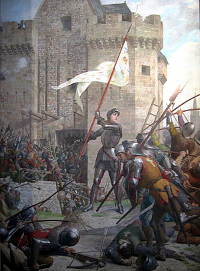The Hundred Years War
Part 6: The Tide Turns
The English army moved on and in 1428 laid siege to Orléans. It was here that one of the most famous names in French history entered the picture. Joan of Arc, a teenage girl claiming to have had religious visions, convinced the Dauphin to allow her to go to Orléans and join the troops defending the city. She succeeded in rallying the troops and led them in turning the tables on the English, taking the fight to them; as a result, the English army broke off the siege. That trend continued, as the suddenly inspired French pursued the retreating English, winning a smashing victory near the village of Patay; in the rout, French troops captured the English commander, John Talbot, 1st Earl of Shrewsbury. 

The French trend of victory continued, and the Dauphin was crowned Charles VII (left) on July 16, 1429. The English followed up with a coronation of their own, crowning the infant heir Henry VI on November 5, 1429. Illustrating just how much French territory England controlled at this late state, Henry VI was also crowned king of France (right) on Dec. 16, 1431. In between Henry's two coronations, England's Burgundian allies captured Joan of Arc, at the siege of Compiègne on May 23, 1431, and sent her to English forces, who quickly tried and convicted her of heresy. She was burned at the stake a week later. 
As when she arrived on the scene, Joan of Arc cast a long shadow after her death. The English king was still too young to rule in a meaningful way, and so the decisions continued to be left to his advisors, who disagreed on how to proceed. England and France met for negotiations at Arras in 1435 but couldn't agree on terms and so no peace was made. In fact, one of England's key allies–Philip III, duke of Burgundy–changed sides and handed Paris over to the King of France. Later that year, one of Henry VI's key advisers, the Duke of Bedford, died. Replacing him was Richard Plantagenet, the Duke of York (the father of two later kings, Edward IV and Richard III). England and France had achieved a brief truce in 1444, and Henry VI had married the French princess Margaret of Anjou on April 23, 1445, at Titchfield Abbey. England broke the fragile truce four years later by sacking lands in Brittany. Next page > The War Ends > Page 1, 2, 3, 4, 5, 6, 7
|
|
Social Studies for Kids
copyright 2002–2025
David White



 Because of the heir's young age, the Duke of Bedford took over the running of the war. He found initial success with a devastating victory at Verneuil, after which the Dauphin's army was on its knees and the Scottish force that had been so important to French defenses was out of the picture.
Because of the heir's young age, the Duke of Bedford took over the running of the war. He found initial success with a devastating victory at Verneuil, after which the Dauphin's army was on its knees and the Scottish force that had been so important to French defenses was out of the picture.
